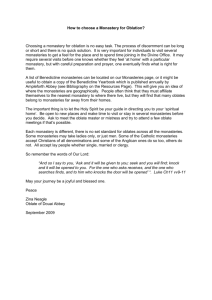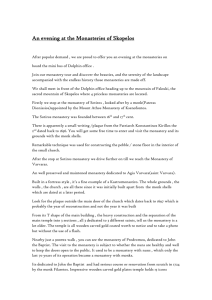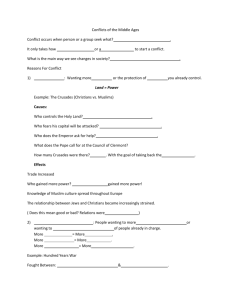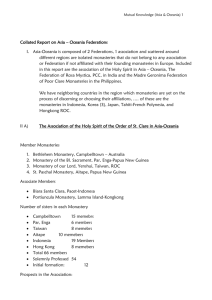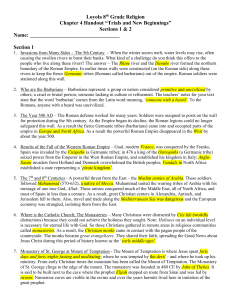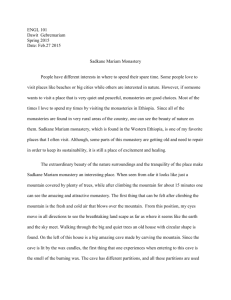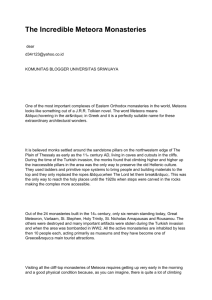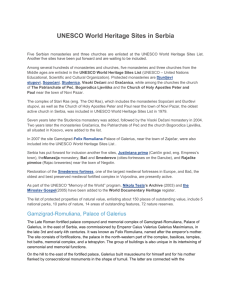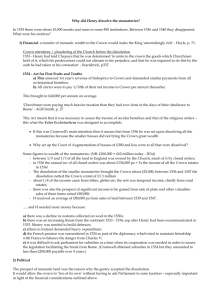The Dissolution of the Monasteries
advertisement
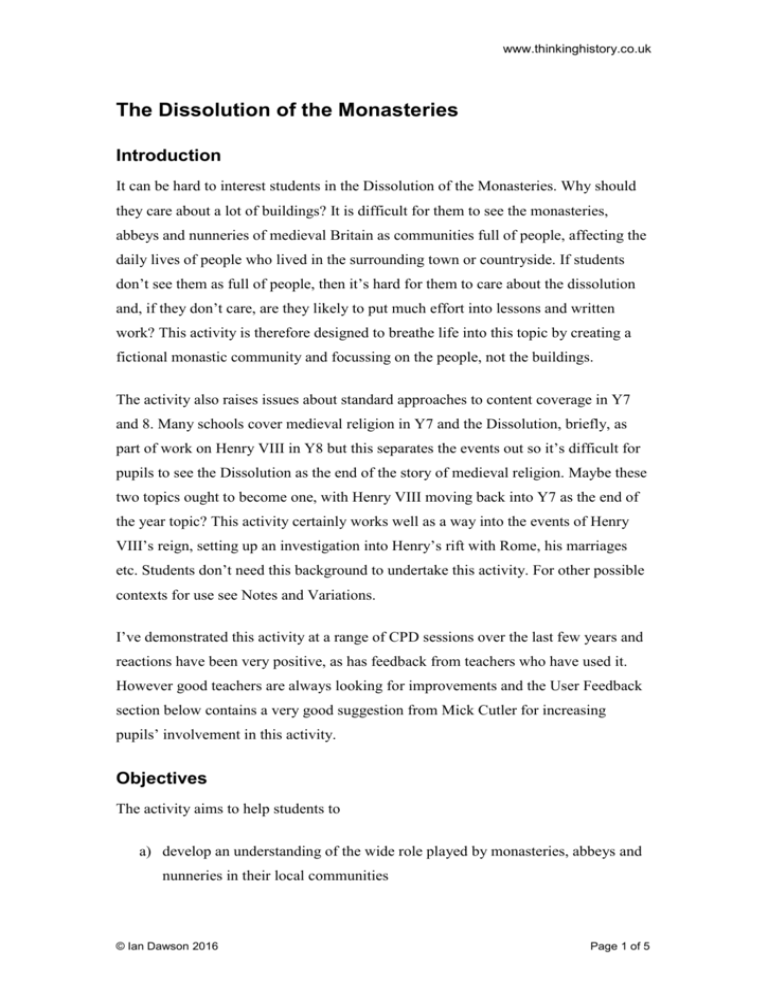
www.thinkinghistory.co.uk The Dissolution of the Monasteries Introduction It can be hard to interest students in the Dissolution of the Monasteries. Why should they care about a lot of buildings? It is difficult for them to see the monasteries, abbeys and nunneries of medieval Britain as communities full of people, affecting the daily lives of people who lived in the surrounding town or countryside. If students don’t see them as full of people, then it’s hard for them to care about the dissolution and, if they don’t care, are they likely to put much effort into lessons and written work? This activity is therefore designed to breathe life into this topic by creating a fictional monastic community and focussing on the people, not the buildings. The activity also raises issues about standard approaches to content coverage in Y7 and 8. Many schools cover medieval religion in Y7 and the Dissolution, briefly, as part of work on Henry VIII in Y8 but this separates the events out so it’s difficult for pupils to see the Dissolution as the end of the story of medieval religion. Maybe these two topics ought to become one, with Henry VIII moving back into Y7 as the end of the year topic? This activity certainly works well as a way into the events of Henry VIII’s reign, setting up an investigation into Henry’s rift with Rome, his marriages etc. Students don’t need this background to undertake this activity. For other possible contexts for use see Notes and Variations. I’ve demonstrated this activity at a range of CPD sessions over the last few years and reactions have been very positive, as has feedback from teachers who have used it. However good teachers are always looking for improvements and the User Feedback section below contains a very good suggestion from Mick Cutler for increasing pupils’ involvement in this activity. Objectives The activity aims to help students to a) develop an understanding of the wide role played by monasteries, abbeys and nunneries in their local communities © Ian Dawson 2016 Page 1 of 5 www.thinkinghistory.co.uk b) appreciate why the monasteries were important to a wide range of individual people c) understand why the closure of the monasteries was therefore so shocking to contemporaries d) stimulate interest in why monasteries were closed as a starter for investigating the reasons behind the Dissolution. Setting Up 1. Set out the room to resemble a monastery and the surrounding community e.g. place chairs in the form of a cross for the church. Also have a chair for each person involved. Mark the key areas used in the role cards by writing their names on large sheets of paper that everyone can see – i.e. the abbot’s lodgings, the infirmary and herb garden, the church, the kitchen, the laundry, the monastery gate, the monastic school, local manor house, the goldsmith’s shop in the local town plus any other places relevant to other roles that you add. 2. Give out the role cards below to individual students. You could add more roles (e.g. a lay brother working in the stables or a wool merchant and shepherd) or pair students up so that one plays the role and the other keeps a note of the main points. The Activity 1. Once students have their role cards and have read them, the first stage is to position people in the monastery. Work round the monastery, asking “who would be in the abbot’s lodgings”, “who would be in the kitchen? “who would be in the local manor house?”” etc until everyone is sitting in their place. As each student takes his or her place, they need to announce their name and role clearly. 2. Now go round all the individuals again, playing the part of an interviewer, asking each person “why is the abbey important to you?” The information is on the role cards but you may need to tease out the details. What you are aiming for is creating the sense that the monastery really mattered to these people. Build up a list of the reasons on the board to underline this and for later use. © Ian Dawson 2016 Page 2 of 5 www.thinkinghistory.co.uk 3. Now we know how important the monastery is, tell everyone that there is a rumour that the King is going to close all the monasteries in the country – or get a colleague to appear as Thomas Cromwell, brusquely ordering the closure on the orders of King Henry VIII. Now ask a) how will this news affect each person? What would they be anxious about? b) what questions do they want to ask? The one you probably really want is “why is this happening?” The Activity is now complete in itself but you have established a springboard for investigating why the monasteries were closed (which can take you back to Luther and the Reformation, Henry’s desire for an heir etc) and also created a sense that this event mattered, that the King’s closure of the monasteries was really important to real, individual people. What happened to all those monks and nuns? Debriefing Debriefing can cover a series of levels listed below. 1. A reminder of factual details – what were the different roles in the monastery? Who in the town was affected by the monastery? 2. Where were monasteries situated? (Students may assume that they were all deep in the countryside, especially if they have been somewhere such as Fountains – you may need to point out that many were in the centre of towns, attached to cathedrals.) 3. Why would the closing of the monastery be important to local people? Would the government take over educating the young, helping the poor, providing work? 4. How did you feel in role when you heard the monastery was to close? 5. How do you think people might have reacted at the time? What might they have done after they heard the news? © Ian Dawson 2016 Page 3 of 5 www.thinkinghistory.co.uk 6. Was this a significant event and why? What did you think about the importance of monasteries before you did this activity? How have your ideas changed? 7. What do you want to investigate next? What explanations can you suggest about why Henry might have closed the monasteries? What do you think all the monks and nuns did? User Feedback 1. From Mick Cutler The dissolution lesson worked well but I have a few ideas for a variation that are germinating. It is along the lines of getting the characters to spend time mixing in role and finding out about each other, perhaps with a record sheet to record very brief details of how they are linked to the monastery. Perhaps giving certain characters people they have to find who can give them 'missing' information from their role card. E.g. the Lord knows he has a problem with his daughter, but doesn't yet know what to do. When he talks to the Abbot, the Abbot's brief will say to tell the Lord he will arrange for his daughter to go to the Nunnery - that sort of thing. The reason for this type of approach is that it took me a whole lesson to read through the cards and although the class did it well, there was a lot of sitting around as each person only had a 1 or 2 minute contribution to the lesson. I am about to fashion a de-brief worksheet. It will enable the characters to record feelings about the monastery, the closure and fears for the future, as well as any questions they want answering. When I announced the closure they were all pretty shocked - there was an audible "oh no!" from many! They all indignantly wanted to know why and as I said all would be revealed next week they said it was like a TV series cliffhanger. I think it did the trick! © Ian Dawson 2016 Page 4 of 5 www.thinkinghistory.co.uk 2. From Sue Korman My students greatly enjoyed the Dissolution of the Monasteries activity. We made some extra role cards and chalked out the monastery in the playground (adding the Inn, Kimbolton and Yorkshire – for Robert Aske).There was much debate about it at break too with students showing friends in other classes the role they had and where they had stood. (Note – the extra role cards devised by Sue are added after the main role cards in the WORD file). Notes and Variations 1. This activity could be used at GCSE by students investigating a local monastic site as part of an SHP History Around Us investigation. It would be best used before the site visit to help students identify some of the key parts of the monastery and to see it as a living community. 2. At A level this activity could be used as a hypothesis about the importance of monasteries in the 1530s. It suggests that monasteries were very important parts of their communities, but were they so important or were they in decline? Students could investigate the reality of the situation, either nationally or by looking at a case-study of a local monastery, looking into the reports of monastic visitations and the arguments of Thomas Cromwell and others about the condition of the monasteries. Reflections 1. Where does this topic fit into your scheme of work? Does it flow from work on medieval religion? Dies it make a good way into work on Henry VIII? How does where it goes help pupils’ understanding? 2. How did tackling this topic through this physical activity affect students’ learning? e.g. was understanding of the significance of monasteries deeper? 3. Did students enjoy the activity and what effects did this have? 4. How else could this technique of building a community be used within your course? © Ian Dawson 2016 Page 5 of 5

